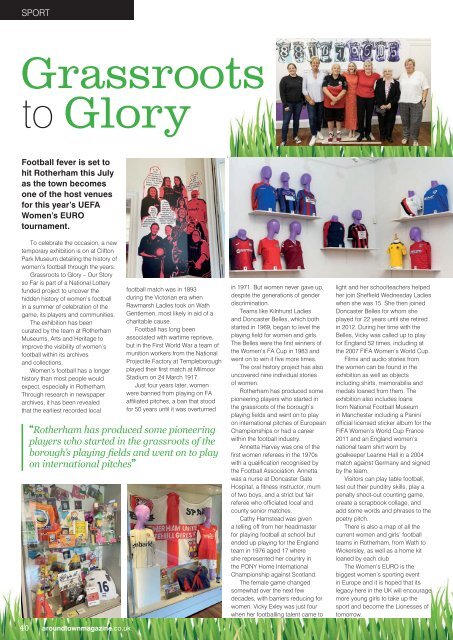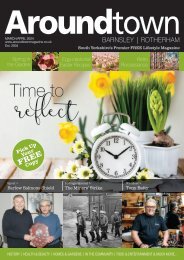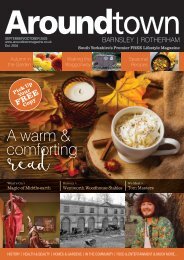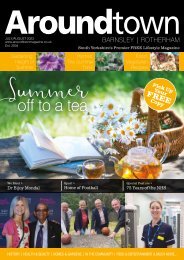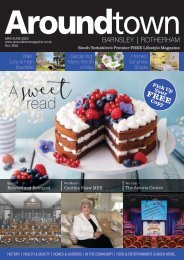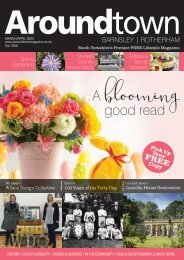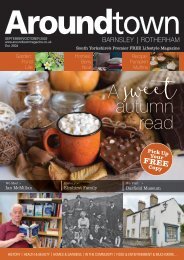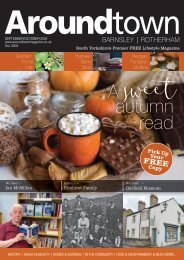Aroundtown Magazine July/August 2022
The July/August edition of South Yorkshire's FREE premier lifestyle magazine.
The July/August edition of South Yorkshire's FREE premier lifestyle magazine.
You also want an ePaper? Increase the reach of your titles
YUMPU automatically turns print PDFs into web optimized ePapers that Google loves.
SPORT<br />
Grassroots<br />
to Glory<br />
Football fever is set to<br />
hit Rotherham this <strong>July</strong><br />
as the town becomes<br />
one of the host venues<br />
for this year’s UEFA<br />
Women’s EURO<br />
tournament.<br />
To celebrate the occasion, a new<br />
temporary exhibition is on at Clifton<br />
Park Museum detailing the history of<br />
women’s football through the years.<br />
Grassroots to Glory – Our Story<br />
so Far is part of a National Lottery<br />
funded project to uncover the<br />
hidden history of women’s football<br />
in a summer of celebration of the<br />
game, its players and communities.<br />
The exhibition has been<br />
curated by the team at Rotherham<br />
Museums, Arts and Heritage to<br />
improve the visibility of women’s<br />
football within its archives<br />
and collections.<br />
Women’s football has a longer<br />
history than most people would<br />
expect, especially in Rotherham.<br />
Through research in newspaper<br />
archives, it has been revealed<br />
that the earliest recorded local<br />
football match was in 1893<br />
during the Victorian era when<br />
Rawmarsh Ladies took on Wath<br />
Gentlemen, most likely in aid of a<br />
charitable cause.<br />
Football has long been<br />
associated with wartime reprieve,<br />
but in the First World War a team of<br />
munition workers from the National<br />
Projectile Factory at Templeborough<br />
played their first match at Milmoor<br />
Stadium on 24 March 1917.<br />
Just four years later, women<br />
were banned from playing on FA<br />
affiliated pitches, a ban that stood<br />
for 50 years until it was overturned<br />
‘‘Rotherham has produced some pioneering<br />
players who started in the grassroots of the<br />
borough’s playing fields and went on to play<br />
on international pitches’’<br />
40 aroundtownmagazine.co.uk<br />
in 1971. But women never gave up,<br />
despite the generations of gender<br />
discrimination.<br />
Teams like Kilnhurst Ladies<br />
and Doncaster Belles, which both<br />
started in 1969, began to level the<br />
playing field for women and girls.<br />
The Belles were the first winners of<br />
the Women’s FA Cup in 1983 and<br />
went on to win it five more times.<br />
The oral history project has also<br />
uncovered nine individual stories<br />
of women.<br />
Rotherham has produced some<br />
pioneering players who started in<br />
the grassroots of the borough’s<br />
playing fields and went on to play<br />
on international pitches of European<br />
Championships or had a career<br />
within the football industry.<br />
Annetta Harvey was one of the<br />
first women referees in the 1970s<br />
with a qualification recognised by<br />
the Football Association. Annetta<br />
was a nurse at Doncaster Gate<br />
Hospital, a fitness instructor, mum<br />
of two boys, and a strict but fair<br />
referee who officiated local and<br />
county senior matches.<br />
Cathy Hamstead was given<br />
a telling off from her headmaster<br />
for playing football at school but<br />
ended up playing for the England<br />
team in 1976 aged 17 where<br />
she represented her country in<br />
the PONY Home International<br />
Championship against Scotland.<br />
The female game changed<br />
somewhat over the next few<br />
decades, with barriers reducing for<br />
women. Vicky Exley was just four<br />
when her footballing talent came to<br />
light and her schoolteachers helped<br />
her join Sheffield Wednesday Ladies<br />
when she was 15. She then joined<br />
Doncaster Belles for whom she<br />
played for 22 years until she retired<br />
in 2012. During her time with the<br />
Belles, Vicky was called up to play<br />
for England 52 times, including at<br />
the 2007 FIFA Women’s World Cup.<br />
Films and audio stories from<br />
the women can be found in the<br />
exhibition as well as objects<br />
including shirts, memorabilia and<br />
medals loaned from them. The<br />
exhibition also includes loans<br />
from National Football Museum<br />
in Manchester including a Panini<br />
official licensed sticker album for the<br />
FIFA Women’s World Cup France<br />
2011 and an England women’s<br />
national team shirt worn by<br />
goalkeeper Leanne Hall in a 2004<br />
match against Germany and signed<br />
by the team.<br />
Visitors can play table football,<br />
test out their punditry skills, play a<br />
penalty shoot-out counting game,<br />
create a scrapbook collage, and<br />
add some words and phrases to the<br />
poetry pitch.<br />
There is also a map of all the<br />
current women and girls’ football<br />
teams in Rotherham, from Wath to<br />
Wickersley, as well as a home kit<br />
loaned by each club<br />
The Women’s EURO is the<br />
biggest women’s sporting event<br />
in Europe and it is hoped that its<br />
legacy here in the UK will encourage<br />
more young girls to take up the<br />
sport and become the Lionesses of<br />
tomorrow.


